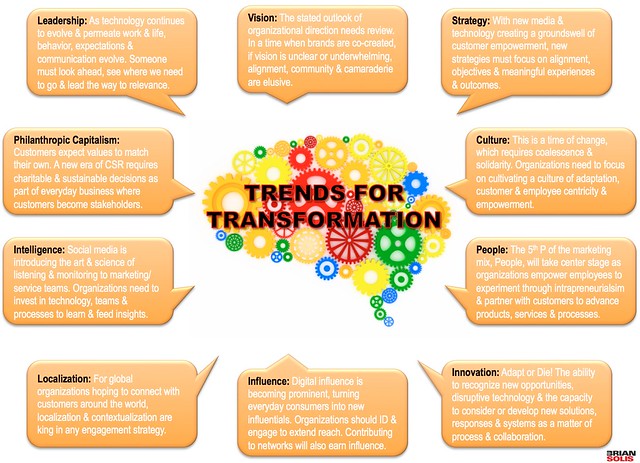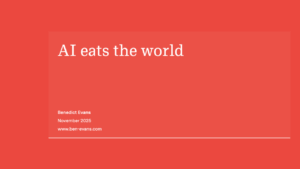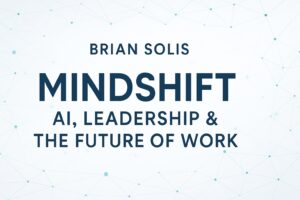Digital Darwinism is a phenomenon when technology and society evolve faster than the ability to adapt. And, it threatens rigid and traditional practices everywhere. It’s no longer just survival of the fittest, but also survival of the fitting. Businesses must earn relevance and to do so requires much more than adoption of the latest technologies or launching endeavors in the latest social or app flavor of the month.
Indeed, this post requires not only your pinterest, but your dedication and creativity. What we’re about to review requires depth not tweeting thoughts. Contrary to the beliefs of those who push the tenets of a social business as a matter of survival, we are not competing for the moment nor are we merely competing in real-time. We’re competing for the future and at the heart of this (r)evolution is relevance and innovation.
Put yourself in the shoes of your customer for a moment. Do you know them? I mean…do you really know them? What about your employees? Have your tracked how behavior, preference, and decision-making have transformed or in some cases splintered from current mainstream activity?
To survive Digital Darwinism takes understanding of course, but more importantly, it takes leadership…it takes courage. It takes the ability to see what others don’t and do what others won’t. The future of business and customer and employee engagement is built upon a foundation of vision, trust, significance, and relationships. Set on this foundation are 10 pillars for which transformation is braced.
These 10 principles serve as the framework for an adaptable business model where opportunities are readily assessed and innovation is regularly practiced. The reward is relevance, affinity and advocacy. As Leon C. Megginson once said in paraphrasing Charles Darwin’s Origin of the Species, “It is not the strongest of the species that survives, nor the most intelligent that survives. It is the one that is most adaptable to change.”
10 Tenets to Survive Digital Darwinism
Vision: The stated outlook of organizational direction needs review. When’s the last time you read your company’s vision or mission statement? If you did read it recently, would you Tweet it proudly? In a time when brands are not created, but instead co-created, if vision is unclear or underwhelming, alignment, community and camaraderie will prove elusive.
Strategy: With new media and emerging technology creating a groundswell of customer empowerment, new strategies must focus on the alignment of objectives with meaningful experiences and outcomes. All too often, emerging technology is confused with either disruptive technology, where is impacts how companies work or how customers behave, or that of yet another channel or platform for traditional marketing or selling. Far too much emphasis, budget, and time is placed in new media channels without an understanding of why or what it is that customers expect or appreciate.
Culture: This is a time of change, which requires coalescence and solidarity. We can’t change if the culture is rigid or risk averse. We can’t innovate if those who experiment are not supported. Organizations need to focus on cultivating a culture of adaptation rooted in customer- and employee-centricity and more importantly, empowerment. Culture is everything. It is and should be intentional. It should be designed. Those companies that invest in the development of an adaptive culture will realize improved relationships that contribute to competitive advantages.
People: The 5th P of the marketing mix, “People,” will take center stage. Organizations that embrace the spirit of intrepreneurialism will empower employees to experiment through failure and success to improve engagement and morale. And, by embracing customers, insights will inspire relevant products, services and processes.
Innovation: The ability to recognize new opportunities is perhaps the greatest challenge rivaled only by the ability to execute. Emerging and disruptive technology is now part of the business landscape and customer lifestyle. Innovation, trends, and hype is not going to stop. In fact, it will only amplify. The capacity to identify and consider new solutions and responses is critical. It must be supported by innovative collaboration and decision-making processes and systems to assess and react. Innovation must be perpetual.
Influence: Digital influence is becoming prominent in social networks, turning everyday consumers into new influentials. As a result, a new customer hierarchy is developing forcing businesses to identify and engage to those who rank higher than others. There is no future in any business model that is cemented in reactive engagement. Organizations should identify and engage all connected customers to extend reach outside of problems. Businesses must engage when touchpoints emerge, during decision-making cycles, when positive experiences are shared, or to proactively feed the results who search for insight and direction. Contributing value to people and investing time and energy into networks of relevance will also earn any organization a position of equal or greater influence.
Localization: For global organizations hoping to connect with customers around the world, localization & contextualization are king in any engagement strategy. This is also true for any engagement strategy regardless of local. Many companies are jumping on every bandwagon imaginable, syndicating content, thinning resources, and investing no more in each network than what’s necessary to maintain a pulse. Facebook, Twitter, Google+, Youtube, Foursquare, Instagram, Pinterest, Quora become broadcast channels for one-to-many strategies and programs that do very little for cultivating dedicated and engaged communities.
Intelligence: One of the biggest trends in 2011 was the development of social media command centers. At the heart of these sophisticated data gathering silos were conversations and tools that allowed community managers to listen, respond, and promote engagement within the company. While social media is introducing the art & science of monitoring to marketing and service teams it is the organizations that invest in technology, teams and processes that will translate activity into actionable insights.
Philanthropic Capitalism: Customers expect values to match their own core values. What used to be a necessary checklist of community focus, such as corporate social responsibility or CSR is now rebooted. Philanthropic capitalism is a business model where companies contribute to worthwhile causes on behalf of customers as part of the transaction. Additionally, customers are expressing that they will also invest in companies where employees are “treated well,” pledging trust and loyalty as a result. The empathetic business model on the horizon requires charitable and sustainable decisions as part of everyday business where customers naturally become stakeholders.

An ode to leadership:
The answers you seek lie in intelligence and empathy. Leadership unfolds in how you translate what you learn and feel into appreciation and understanding of the state of customer sentiment and how that correlates to the state of customer relationships.
Once you listen, not monitor, but truly listen to customer activity and observe online behavior, you cannot help but feel both empathy and harmony. And naturally, the response it begets is only human.
#AdaptorDie
Order The End of Business as Usual today…







With Strategy, you can’t really pull the wool anymore. Be straight with clients and consumers or you will get burned. For medical experts alone, think about how many Web MD’s there are in the world that know they might have a disease. People know more about a product before they buy it than some of the people selling it. They may not know the long term benefits and the money saving ability it may have. Enlighten them and you should be ok.
Excellent model! I used it as an evaluation matrix to evaluate our primary technology model. Just rate the subject company on a scale 1 to 10 for each of the tenants. Then, add up the scores and you have your Digital Darwinism “grade.”
Thank you Steve! I was working on something like this to help champions expedite change within the organization. Cheers to you!
Great model here Brian.
What do you think about drawing a circle around this model to illustrate ’empathy and humility’? Empathy and humility are the glue that binds for true listening, engagement and co-creation. It categorically states and enables organisations to recognise that they don’t have all the answers yet are absolutely willing to integrate feedback from their current and future stakeholders into their (r)evolution. Empathy and humility sets a tone for any organisation to respect their stakeholders and requires them to act a certain way to represent the core beliefs and behaviours of their organisation.
For example, in my homeland of Tonga (South Pacific), we have a national creed that says “Ko Tonga Mo’unga Ki He Loto” translated literally means “the mountain of Tonga is within you”. It’s a metaphor that we as a people are raised to learn and practice by leading with our hearts, to be humble and selfless. The irony is, we don’t have any mountains of note in Tonga. In defeat and in winning, humility and empathy is our strength. This is a practice that any organisation can adopt and integrate with what they’re doing now.
When we recall the leaders who we admire the most, gravitate to, who stand out most in our minds, do we ask why? Is it the person who recognises the hard work of their people? is it the leader who is genuinely thankful for their stakeholders contribution and cites/personalises the gratitude with specific acts/events naming specific people who help make them successful? is it the leader who puts the interests of their people/stakeholders first knowing that that act in itself is in the best interests of the business? is it the leader with the vision and clarity of thought to inspire their people to be better than their best to implement the strategy and necessary tactics to achieve their final objective? is it the leader with the flexibility of mind to adapt with market changes and empower his people to ‘play’ in the sandpit, develop and experiment with new opportunities that may drive their future revenue streams? is it the leader that encourages all it’s people to listen, be informed, engaged, empowered, and to inform it’s stakeholders about their business using the ‘social phone’ to connect where they are? is it the leader who understands that having a direct relationship with society as a whole, by illustrating through words and deeds their core values, increases the likelihood of investment in their business through either being the first choice for employment, customer acquisition and advocacy online and offline?
A great leader can do all these things and more. However, to start the process of continuous improvement to survive Digital Darwinism, every business needs to appreciate that they don’t know everything. They need stakeholder/society contribution. To plug this gap in their knowledge base to survive and grow, the functions of unlearning, relearning and application/execution/collaboration/co-creation process begins with the attitudes and practices of humility and empathy. ‘Two ears, one mouth’ thinking. Effectively listening more, ‘speaking’ more efficiently with the heart and letting your positive actions do your talking while recognising and being grateful for the lessons.
May the ripples of inbound marketing start by placing the ‘people’ elements and the kaizenning of their positive experiences at the centre of business.
Love this @briansolis:disqus . I like the simplicity yet ability to drive to a deeper conversation. Have a few clients I can leverage this immediately.
Just had a deep dive conversation / planning session with a client last week that is struggling with relevancy yet aren’t able to see such.
I think there are a large number of biz’s who want to integrate social into the DNA of their biz yet they are having great difficulty understanding what it means and tend to simplify to the extreme. They’re getting hung up on the community level metrics, tweets and retweets which is giving them a false perception of success. If they are “social” by nature then they get stuck at the social part and are in reality losing touch with their core audiences that matter. I see it presenting much risk as they are losing touch with their customers, partners and other stakeholders. I think many would be surprised the response of their priority audiences if asked their honest perception of the brand and their communication.